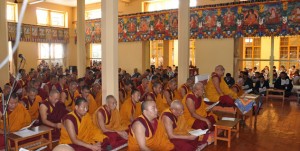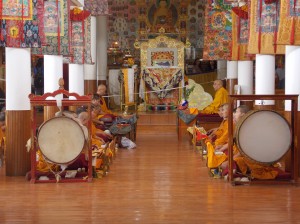
Namgyal Monastery’s abbot presiding over a grand prayer service on the international solidarity day for Tibet in Dharamsala, India.
Photo: Tibet.net
In Dharamsala and around the world, Tibetans and their global supporters celebrated International Tibetan Solidarity Day on 17 May. Organised by the Central Tibetan Administration (CTA), the day was marked by expressions of support through events and prayers. Supporters were also urged to contact their local authorities to draw attention to the ever-decreasing human rights situation within Tibet.
The event comes at the culmination of rising tensions and increased awareness of Tibetan grievances. As many as 117 Tibetans have self-immolated since 2009, and global leaders are increasingly confronting the Tibetan issue in public.
The purpose of the event, the last of which was held on December 10 2012, was both to demonstrate a rejection of Chinese authority and abuses, and to continue to reassure Tibetans living inside Tibet that ‘their plight has not been forgotten by the rest of the world’.
International Tibetan Solidarity day also honored the date when the 11th Panchen Lama disappeared in 1995 aged six. The CTA stated that ‘his fate symbolises that of many other brave Tibetans who continue to be imprisoned and deprived of their basic human rights’. With his wellbeing unknown, calls were made to further Tibet’s ‘immediate and long term religious, political and ethnic well being’.
May 17 therefore stood as an important date for Tibetans, but it represents more than just another attempt to raise awareness. ‘Now, more than ever before, Tibetan people need to be reassured and given hope’, the exile Tibetan administration said. The events of Solidarity Day aimed to continue to give Tibetans globally this important reassurance, so vital to a community in exile, and a population experiencing great suffering.
In its official statement, the Tibetan parliament outlined its eventual hopes for the global continuation of International Tibetan Solidarity Day, stating: ‘[Tibetans] remain hopeful that as a result of this day being observed in places across the world, definite appreciable gains will be seen in the furtherance of the Tibetan cause’.




 Print
Print Email
Email